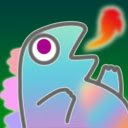*全文(PDF)はここをクリック!
Philip Yenawine & Linda Duke
速記:ジョンオール/翻訳:徳 雅美
カリフォルニア州立大学チーコ校
Linda: It's not based on an expert coming in, it's not based on any kind of access to fancy resources. It is something that can be done in any school.
VTSは誰か専門の人の指導に依るものではなく、特別な手段方法が必要でもありません。これはどの学校ででも簡単に実施できるものです。
Narration: The Visual Thinking Strategy curriculum provided a context for elementary school classroom teachers to help students find meaning in works of art. Art becomes the topic of facilitated discussions which stimulate thinking and the development of communication skills. This program is based on the research of psychologist Abigail Housen.
VTSカリキュラムは小学校の先生方へアートの意味を生徒たちに考えさせるための方法を紹介しています。アートは討論の良い題材であり、またコミュニケーション技術の発達を促します。VTSは心理学者であるアビゲルハウセンの研究を元にして作られています。
Philip: VTS (Visual Thinking Strategy) is really designed to reintegrate art into people's lives as it always has been through all of history. It teaches a process, a process of making discoveries on your own by using your observations and your capacity to draw on your memories, your associations, your experiences with the world to find certain kinds of meaning.
VTSは、かつて(歴史上)アートが我々の身近に存在していたように、再度アートを我々の生活の中に取り戻すようデザインされています。VTSはアートを良く観察することによって自分自身を発見する方法を教えてくれます。
Linda: One of the things that VTS does very well is to convey the idea that art makes us think, that it's about human experience.
VTSが良く機能している一つの理由は、それがアートを通して思考することの大切さを教えてくれるということです。思考するということは人間の存在理由でもあります。
Philip: We don't teach thinking really, very often, we teach at right answers. We teach information and skills. And there's a skill involved in this in terms of careful thinking. But careful thinking is a matter of speculating and occasionally being wrong. There's not a great thinker in the world who hasn't had a bad idea. But that's the way we grow.
我々は実際には(子ども達に)考えるということを教えていません。実は正しい答えを得るということだけを教えています。我々は情報と技術を教えています。技術を持つということの中には、注意深く思考するという意味を含んでいます。ところが注意深い思考であっても時には間違った答えを導き出すこともあります。間違った考えなど持たない偉大な哲学者存在しないのです。しかしまた間違うことにより我々はまた成長していくものなのです。
Linda: It is the nature of art that many different perspectives, points of view can be equally valid and the more of those that are shared and brought together by the group, the more in depth their understanding of the work.
アートというものは、多種多様な見方がありますが、各々の見方考え方を尊重し、さらにグループの中で考えを共有することによって、もっと深くアートを理解することができるようになります。
Philip: There are a number of elements in the strategy that make it work. One area is asking good questions.
VTSを如何に効率的に使うかにはいくつかの要素があります。一つは(子ども達の討論対話を導き出す)良い質問をすることです。
Linda: "What's going on in this picture?" is a very non-directive opening question, opens the floor for a wide range of responses.
「この絵の中には何が起こっていますか(何が見えますか)。」という質問は間接的な開かれた質問であり、多くの答えを導き出すことができます。
Philip: We don't ask them why, we ask them "what do you see that makes you say that?" because that keeps them rooted in the picture and the world we share, it makes them give concrete evidence of the thought that they've had and is a much less threatening question than "Why do you think that?"
我々は(子ども達の答えに対して)「なぜ(そう思うのか)」と問い返したりしません。そのかわり「(絵の中の)何を見てそう答えたの」と問い返すことによって、絵の中から直接自分の出した答えの理由(証拠)を見付け出させるようにしています。この問いかけは「なぜそう思うか。」に比べずっと楽にその答えを導き出すことができます。
Another very important aspect of managing the discussion has to do with linking answers. Hearing a variety of disparate points that one says, "Ah, we see a lot of different possibilities here," or at another time we say, "We seem to be agreeing about certain kinds of things," and pointing that out.
子ども達の討論対話をうまく操縦するもう一つの重要なポイントは、彼等の(全く関係のないように見える、または相反する)答えをうまく繋げてあげることです。(例えば)異なった意見に対して「この絵の見方にはいろんな可能性がありますね。」とか等々。
Philip: The attempt is to not judge an answer as silly, not judge it as irrelevant, not say a question is a bad one but to say, "everything is legitimate."
これらの子ども達との会話のやりとりは、くだらない答えとか、関連性のないものとか、ばかげた答えとかの判断を下すためのものではありません。「全ての答えに意義がある(間違った答えなどない)。」ということを子ども達に知らせる必要があります。
Linda: In some cases, I think children don't feel that they're bringing a lot to the table that's valued by adults. But VTS is very much about the wonder of what people can bring to a conversation with careful looking and thinking and sharing ideas.
時として、私は、子ども達自身が自分の考えはみんなの前でいうほど価値のあるものではないと卑下しているように見えることがあります。しかしVTSでは、他の人々がアートをどのように見、そして考えているかをお互いの対話を通して交換させることにより、彼等の探究心を満足させることができます。
Philip: Being able to tell stories is probably being able to participate in one of humankind's oldest traditions. It's probably very important to get kids to find their own stories in the world around them and to tell their own stories to help them understand themselves. But if we ask them using a work of art as a starting, place quite often we have something concrete that makes it so that they don't just have to invent, but that they anchor their stories somewhere in a real world, a world that we all can share.
物語りを語ることは、我々人間が昔からもっていた習慣の一つです。それは子ども達にとってもとても重要なことで、自分の物語りを創造し、それを語ることによって自分自身を理解することにも繋がるからです。しかしもし、子ども達が単に自分勝手な物語りを作るのではなく、アートを見ることによってそれから触発されて物語りを創造するのであれば、その物語りはそのアートを見ていた全ての人と共有するものであり、他の人々にとっても意味のあるものとなります。
Linda: The basic strategies are so simple. They can be learned quite easily, so that if a teacher doesn't happen to have a background in art, he or she quickly discovers that that needn't hold them back at all.
VTSの基本的な方法はとても簡単なものです。たとえ教師に美術(史)を学習した経験がなくても簡単に学ぶことができます。
Philip: What Housen's search has revealed is the richness of people's thinking when they are trying to find meaning in work of art.
ハウセンが研究調査によって何を発見したかと言うと、人々がアートの意味を見い出そうとする時、如何に豊かな発想をするのかということです。
Housen's theory is the basis for most of our decision making. She began a process 20 years ago that involves looking very closely at what people do when they look at works of art. This is what gives us the information we need to create teaching structures.
ハウセンの理論は我々のVTS作成の最も重要な元となっています。彼女は20年以上前から美術館にやってくる人々がアートにどのように反応するのかを良く観察しデーターにまとめています。この研究は我々にVTSを作るに当たっての貴重な情報を与えてくれました。
Art is very useful because it is concrete. It sits in front of you and there is data to pick apart. So what they learn is not only about a work of art, but very much about themselves and about each other and about a process of coming to meaning together collectively.
アートは確実に存在するものなので(実は自分を知るのに)非常に役にたちます。アートを通して学べるのはアートに関してだけではありません。実は自分自身、他の人々、そして、アートを見て考えるプロセスを学んでいるんです。
Linda: We hear teachers very often noting that students will look longer at visual materials, whether it's a petrie dish or a slide or a diagram or a photograph in their social studies look ....
我々が先生方から良く耳にすることは、子ども達が例えば社会の教科書を読むとき、視覚的なイメージの方(例えば、実験皿、スライド、図表、写真)を文章よりも長く見ているということです。
Philip: In normal classroom discussions, there's a pretty predictable 25 % maybe 40% during some discussions, who participate. What we find typical in VTS discussions is that more like 90% do. And not talking about every slide, but over the course of even two or three slides, most kids have their hands in the air; most want to contribute.
通常のクラスの討論では25%もしくは多くても40%の生徒しかその討論に参加していません。しかし、VTSの討論では90%以上の生徒が参加しています。VTSのコースを通して、多くの生徒達が手を上げ、自分の考えを話し、皆と考えを交換しようとしているのです。
Linda: So I often hear teachers saying, "I am so proud of my kids, I had no idea that so and so had ideas like this." It's just really beautiful to see this unfolding.
私は先生方が度々こういうのを耳にします。「私は自分の生徒たちを誇りに思っています。あんな風に物を見、考えるなんで想像もつきませんでした。」教師と生徒のオープンな関係を目にするのはとても素晴しいことです。


No comments:
Post a Comment